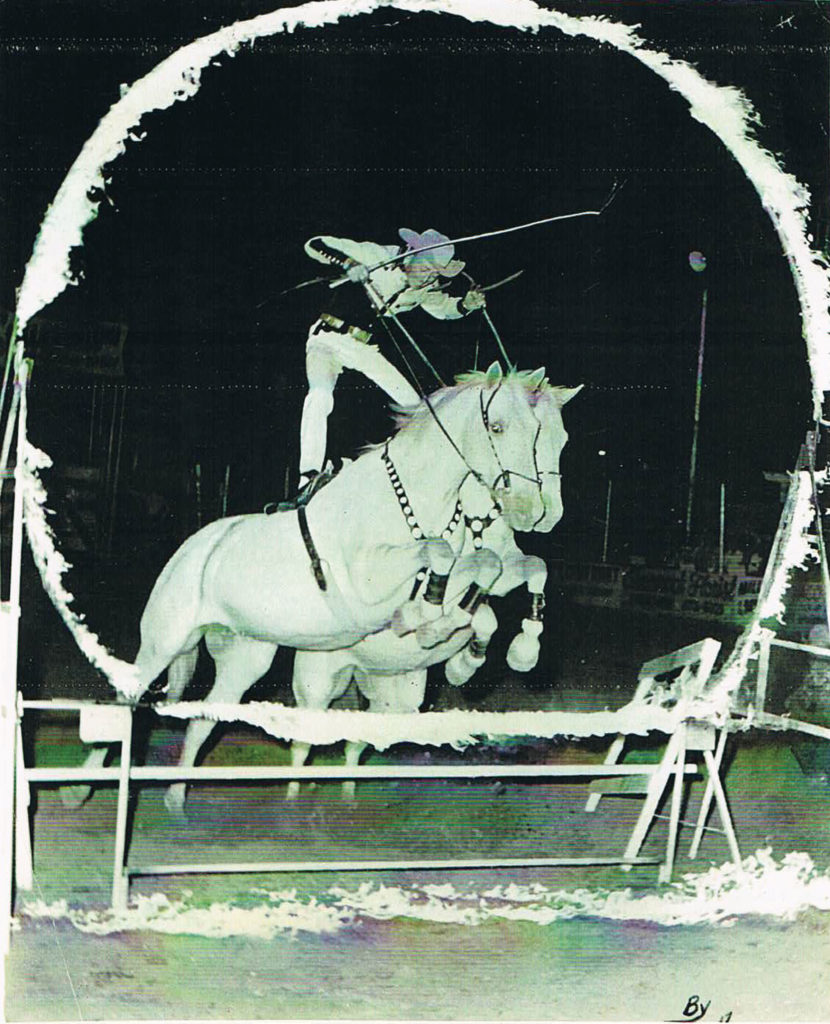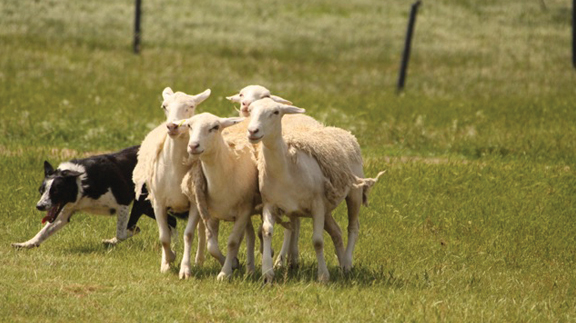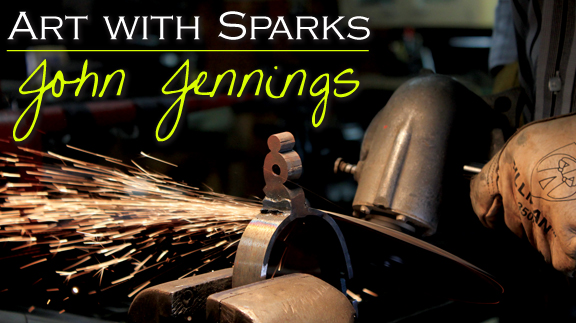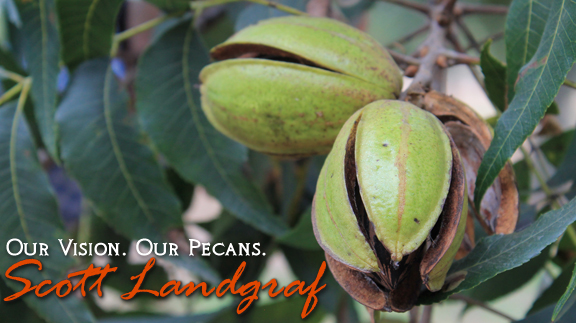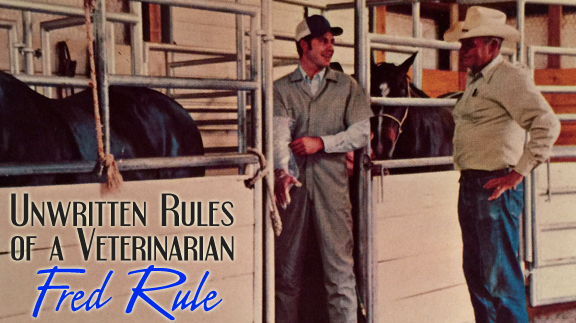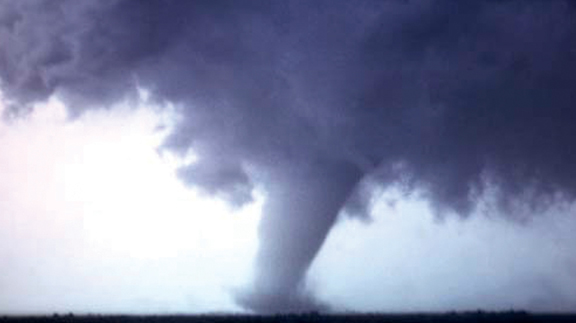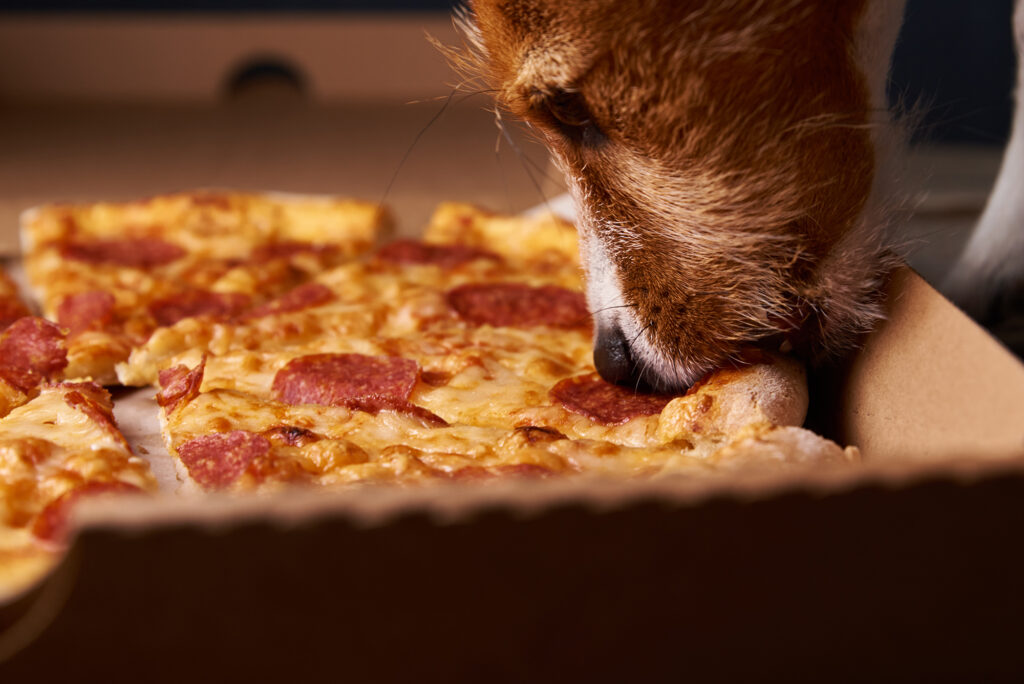Country Lifestyle
June 2017 Profile: Wayne Cornish
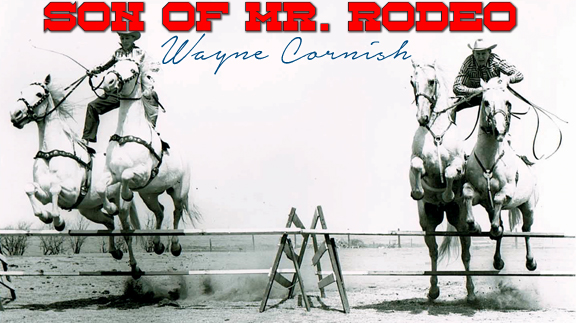
Son of Mr. Rodeo
By Laci Jones
Eighty-two-year-old Wayne Cornish walked through his home in Enid, Okla., that is filled with old memorabilia and talked as if the photos were taken yesterday. He pointed to a large black and white photo of two men jumping over a fence while standing atop two Roman riding teams. The two men in the photo happen to be Cornish and his father, Cecil Cornish.
“I’m going to tell you a story,” Cornish began.
A man came to their farm near Waukomis, Okla., requesting to take a picture of the father-son duo. Cecil told the photographer, “We are going to have to get them ready, but I guess we will get a picture.” They took their Roman riding teams—Cornish’s “The Flying White Clouds” and Cecil’s “The Golden Eagles” to the pasture and the picture was taken.
“It was the first and only time they jumped together,” said Jackie Cornish, Wayne Cornish’s wife of 22 years.
Formerly known as Mr. Rodeo among his friends, Cecil was born in 1909 in Waukomis, Okla. He began his rodeo performance career in the 1930s. As an animal lover, he began training a six-month-old colt named Smokey to perform tricks, later becoming one of his favorite acts. The pioneer performer taught Smokey how to dance, shake hands and play dead, among other entertaining tricks.
While he initially took to the rodeo circuit competing as a bronc rider and roper, he later began performing. Arguably, his most famous acts included Smokey, his Brahma bull named Danger, six Palomino liberty horses and his Roman riding team. Throughout his career, there were three Danger bulls, which he taught to jump over a car as well as other tricks.
Throughout his career, Cecil performed with other legends including Gene Autry, Roy Rogers, Red Ryder and Little Beaver. He was a member of the Cowboys Turtle Association, the predecessor of the Rodeo Cowboys Association, later becoming the Professional Rodeo Cowboys Association.
He performed across the United States and Canada including Madison Square Garden in New York and the Cow Palace in San Francisco. The pioneer performer once estimated he performed in more than 800 rodeos, according to an article written by Randy Witte in the December 2000 issue of “Western Horseman.”
In the prime of his performance career, Cecil and Juanita were married in 1933. With Juanita making his fancy show attire, the couple often traveled together for performances. His outfits were as memorable as they were colorful and elaborate, according to his biography in the ProRodeo Hall of Fame.
Two years after Cecil and Juanita were married, their only child was born in Waukomis, Okla., on Feb. 2. Following in his father’s footsteps, Cornish began performing at a young age. His rodeo debut was at the age of five when barrel men John Lindsay and Hoyt Heifner put Cornish on a calf in Ponca City, Okla.
“I rode him plum across the arena,” Cornish said with a laugh. “I remember my boots fell off, but I rode that bull.”
The bullfighters laughed about the performance and gave the young bull rider $4 for his rodeo debut. During this time, Cornish also performed in Cecil’s act where Danger would jump over a car.
“I would lay down in the back seat, the bull would jump over us and I would crawl out and act like I had been sleeping,” Cornish laughed.
The Cornish family traveled from coast to coast together throughout his childhood. In fact, he spent more time on the road with his parents than in school. The family was at a rodeo across the United States when Juanita said Cornish needed to get back to school. Cecil said the experience would not hurt the young performer, but Juanita insisted.
“They got Wayne back to school, but Cecil wasn’t happy about driving all the way back here and all the way back to the rodeo,” Jackie explained.
Cornish was later expelled from school because of his absences, after working a rodeo in east Texas. Cecil visited the school board to get Cornish back in school.
“Cecil said, ‘He probably learned more from going to the rodeo than he would’ve in school,’” Jackie added.
The school allowed the student to return to school, but he continued to travel the rodeo circuit. The rodeo clown got his Rodeo Cowboys Association Card in 1953 and graduated from high school a year later.
It wasn’t long before commentators referred to Cornish as “a chip off the old block who is rapidly becoming a block of his own.” Like his father, many of Cornish’s acts included animals—six golden liberty horses, a pig Cornish referred to as a garbage disposal and The Flying White Clouds.
He started working with The Flying White Clouds in 1953, performing many tricks which included jumping through rings of fire. Cornish said his dad helped him train Susie and Sallie, sisters in The Flying White Clouds, but Ed Curtis helped the performer at an event in Kansas. He said they had a light show and one of the horses fell over backwards during the jump, throwing Cornish. Curtis helped get the horses under control, he added.
“To this day, they always jump perfectly,” Cornish beamed. “They were a perfect, perfect act and they were never hurt again.”
While he continued his specialty acts, Cornish preferred clowning and being a barrel man. Cornish has more than 20 years of stories while wearing the clown suit and painted face.
“We didn’t know we was rodeoing,” Cornish explained. “We worked hard.”
He performed with some of the best rodeo clowns including Oklahoma natives Dixie Mosley, Junior Meek and Jim Hill, describing them as “some of the best in the world.” Performing was not always work as many of the rodeo clowns enjoyed pulling practical pranks on one another.
It once snowed the night before a scheduled rodeo in Utah, and Cornish said there were maybe three or four people in the stands watching the rodeo. He came out with his old suit on because he did not want to get muddy for only a few people.
“[Jim Hill] moved over behind me and shoved me down in the mud, but I got him,” he recalled. “He said, ‘We need a picture,’ so I hit him. He was a funny act.”
Cornish once performed in front of then-President Harry S. Truman at a rodeo in his hometown of Independence, M.O. Margaret Truman accidentally stepped on her dog’s tail, making the dog yelp.
The yelp sounded like the nickname for former president, Dwight Eisenhower, “Ike.” Cornish told the former First Lady that he would have to shoot the dog for yelping “Ike, Ike, Ike.” The rodeo clown said President Truman just laughed.
Cornish worked as a rodeo clown in many of the rodeos his father performed in, and they often traveled together from coast to coast. Together, they worked in large rodeos as well as the small, local rodeos.
Being a rodeo clown and performer does not come without risks. Like many rodeo cowboys, Cornish suffered from many injuries including broken ribs to broken shoulders. A broken neck in 1962 prevented him from working in the National Finals Rodeo in Oklahoma City.
The injuries he sustained throughout his career was one of the reasons Cornish put away his clown outfit. Another reason for quitting was because of Cecil. By 1971, Cornish said the animals were getting older, which lead Cecil to decide on retiring after returning from a rodeo in Evanston, Wyo.
“He said, ‘Son, I want to tell you something. Smokey is getting a lot of miles on him, and I had pretty good luck for all them years that he had,’” Cornish recalled. “Some people really thought they were a good act and they were.”
While he no longer performed as a rodeo clown or performer, Cornish remained invested in the rodeo circuit by hauling horses. Traveling across the United States and Canada, he hauled horses for Ashland, Neb., Hull and Smith; Walter Merrick, race horse breeder from Sayre, Okla.; and Betty and Dee Raper, Belle Mere Farm in Norman, Okla. Cornish said he was always on the road, and he once got a call from Raper who was checking in on him.
“He said, ‘Wayne, are you all right?’” Cornish recalled. “I said, ‘Yes sir, I’m working and busy. I got things to do.’”
Jackie said the Rapers said they have never had anyone before or since Cornish who was as responsible. He hauled racing horses and roping horses. Among those horses included Genuine Risk, one of three fillies that won the Kentucky Derby.
“I hauled a lot of horses—good horses from Florida to California,” Cornish added.
Cornish said he later started hauling livestock but quit because of his daughters. When asked if he missed being on the road, he said “I do” without hesitating.
Since then, he has attended many rodeo clown reunions. One reunion was held at Oklahoma City. Donning his clown suit, he and nine other rodeo clowns raced donkeys and mules in Remington Park. Cornish laughed and said he wanted to prove to the other clowns that he could win the first mule race held at Remington Park, and Cornish succeeded. He was awarded a belt buckle for the achievement.
Among his many achievements includes a lifetime member of the PRCA. The former rodeo clown has received the Andy Womack Memorial Award, named after a rodeo clown from the ‘30s to ‘40s. The memorial award is the highest award a rodeo clown can receive.
In 1991, Cecil was inducted into the National Cowboy Hall of Fame, and was inducted into the ProRodeo Hall of Fame in 2003. He died later that year in Enid, Okla.
The Cornishes collected many years’ worth of rodeo memorabilia. In 2010, a storm caused them to pack the memorabilia including photos belt buckles, medallions and other irreplaceable items into a large suitcase and other bags.
They took the items to Jackie’s mother’s storm shelter to keep them safe. They did not tell anyone where they put the memorabilia, but Jackie was apprehensive about leaving the precious items. She suggested putting a padlock on the storm shelter, but Cornish and her mother believed the items were safe.
“We go over to get [the memorabilia] and this one big suit case that would’ve taken two people to get it out of there is gone,” Jackie recalled. “We searched everywhere, and I know nobody would have just taken them and thrown them away.”
The irreplaceable items have yet to be returned. Some memorabilia, including the barrel Cornish used in his rodeo clown days, is on display at the National Cowboy and Western Heritage Museum in Oklahoma City.
Two years later in August, Cornish had a brain aneurysm. When they arrived at the hospital, the neurosurgeon showed Jackie a picture showing the blood clot in Cornish’s cranium and told her he was likely going to die. The neurosurgeon presented the option of surgery, but the chances of the former rodeo performer surviving were minimal.
“I went up to the chapel and said a lot of prayers,” Jackie recalled. “I said, ‘If he can’t be himself, then take him, but if he can, leave him here because I need him.’”
Cornish survived the surgery and was taken to the intensive care unit. While many still believed Cornish would not survive, Jackie knew he would. The aneurysm affected his central nervous system on the left side, impacting his vision and speech, she added. Five years later, Jackie supports Cornish by serving as his eyes and helping tell many stories of his career in the rodeo circuit.
“There’s not much I can do without her,” Cornish added.
Cornish and Jackie met when they were teenagers and were high school sweethearts. Their families were good friends, but Jackie’s parents thought Cornish was too old to date her.
“I always liked her,” he explained. “I really did like her.”
They went on to marry other people, but they were reunited 30 years later. The couple married in 1995. The couple has six daughters from previous marriages: Donna Kay, Shawna, Jacquetta, Kelly Ann, Kimberly and Karen.
“I am so blessed that he is still here,” Jackie said and she laughed. “He is just so funny.”
While the Cornishes only attend a few local rodeos each year, Cornish enjoys making people laugh and reminiscing on the days when he wore the clown suit.
This article originally appeared in the June 2017 issue of Oklahoma Farm & Ranch.
Country Lifestyle
Farm Dogs & Table Scraps
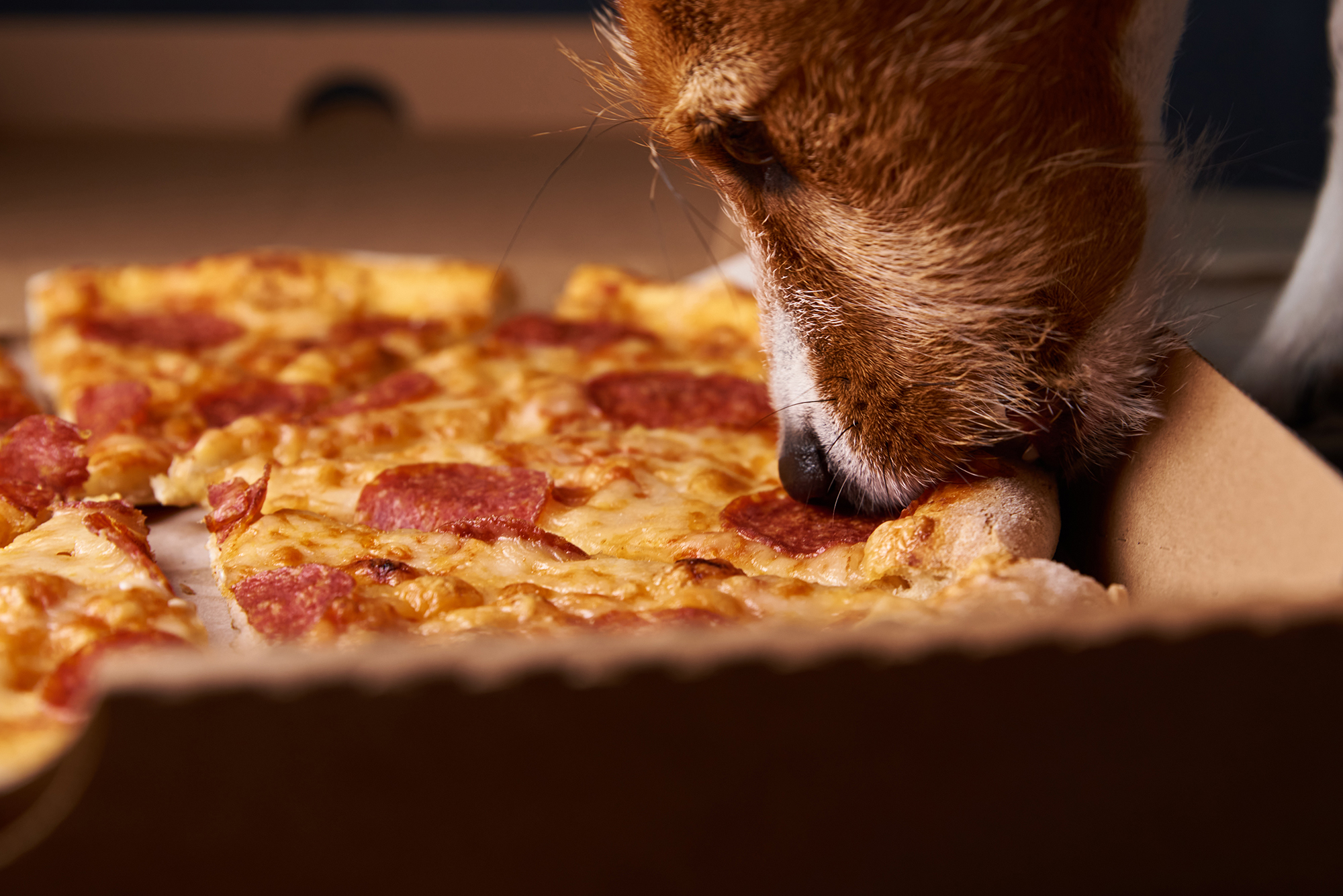
What’s Safe and What’s Not?
Growing up on a farm, our dogs were tough. They roamed the pastures, slept under the barn, and ate just about anything they could get their paws on—whether we meant for them to or not. I’ll admit, I never thought twice when one of our old cow dogs snatched a biscuit off the table or licked up a spill from the barn floor. I’ve even seen a dog steal a whole rib bone off a plate and trot off like he’d won the lottery. And somehow, they always seemed fine.
But here’s the thing—just because they survived doesn’t mean it was safe. For every farm dog that lucked out, there’s another that wasn’t so fortunate. Some human foods can be downright toxic to dogs, and a little bit of bad luck (or a smaller, more sensitive dog) can turn a harmless snack into an emergency.
Common toxic foods lying around the farmhouse
If you’ve got a farm dog—or any dog, really—you need to be aware of the dangers lurking in everyday foods. Some of the biggest culprits include:
Chocolate – The darker it is, the worse it is. Even a little can cause vomiting, seizures, or worse.
Grapes & Raisins – No one’s exactly sure why, but they can cause kidney failure fast.
Onions & Garlic – In large enough amounts, these can destroy red blood cells, leading to anemia.
Xylitol (Found in Sugar-Free Gum & Candy) – This artificial sweetener can send a dog’s blood sugar crashing and cause liver failure.
Alcohol – Even small amounts can be deadly to dogs, affecting their nervous system much more than it does ours.
Bones from Cooked Meat – While not necessarily toxic, they can splinter and cause serious internal injuries.
Macadamia Nuts – These can lead to weakness, vomiting, and even paralysis in dogs.
What to do if your dog eats something toxic
First, don’t panic—but don’t ignore it either. If you know your dog ate something dangerous, call your vet immediately. They can tell you whether to induce vomiting or if it’s something that requires urgent care. If it’s after hours, contact the ASPCA Animal Poison Control Center (888-426-4435) or the Pet Poison Helpline (855-764-7661).
Prevention is always the best medicine, so keep toxic foods out of reach. That might mean keeping the trash can secured, making sure kids don’t slip the dog a treat under the table, or just being more mindful of what’s left on the counter.
Our farm dogs might have been lucky, but luck isn’t a great strategy when it comes to their health. A little awareness goes a long way in making sure they stay happy, healthy, and ready for the next day’s work.
For more information
ASPCA Animal Poison Control: www.aspca.org/pet-care/animal-poison-control
Pet Poison Helpline: www.petpoisonhelpline.com
Visit www.akc.org/expert-advice/nutrition/foods-your-dog-should-never-eat
Country Lifestyle
Summer Squash and Corn Chowder
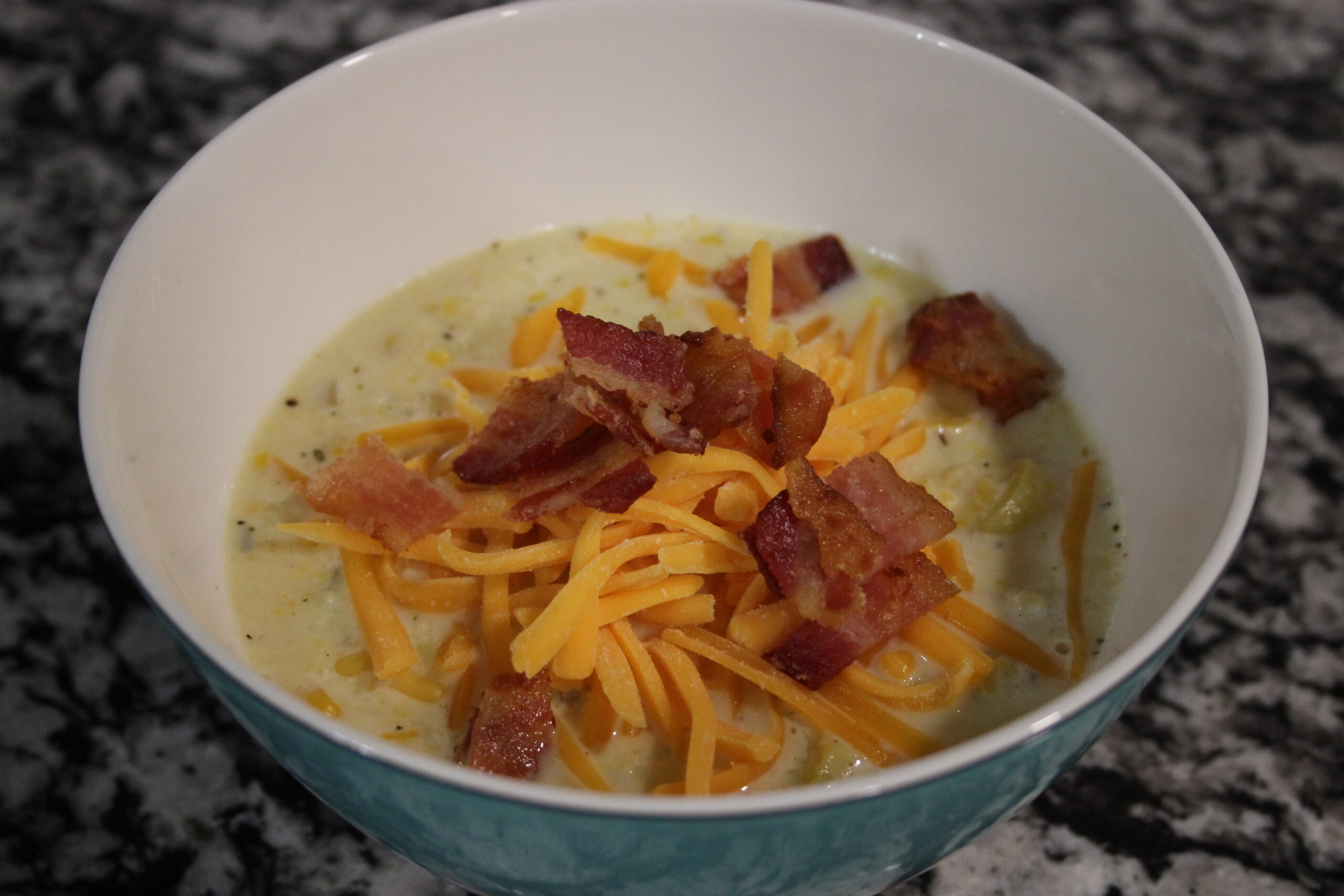
By Lacey Vilhauer
Total time: 40 minutes
Servings: 6-7
Ingredients
- 6 slices bacon, cooked and crumbled and 1 1/2 Tbsp rendered bacon fat reserved
- 1 1/2 lbs yellow squash, chopped (about 3 medium)
- 2/3 cup thinly sliced celery
- 1 cup diced onion
- 1 Tbsp flour
- 2 cloves garlic, minced
- 2 3/4 cup milk (I used 1%)
- 5 cups canned or fresh cut corn (from about 6 ears corn), divided
- 1/2 cup heavy cream
- 1 1/2 tsp chopped fresh thyme (or 1/2 tsp dried)
- 3/4 tsp salt, then more to taste
- 1/4 tsp freshly ground black pepper, then more to taste if desired
- 3/4 cup shredded cheddar cheese, for serving
- Chopped green onion for garnish (optional)
Instructions
Heat 4 tsp reserved bacon fat in a large pot over medium-high heat. Add celery and onion and sauté 2 minutes then add the squash.
Saute until tender, about 6 minutes, adding in garlic and flour during last 2 minutes of sauteing. Reduce heat slightly.
Add 1 1/2 cups milk, 2 cups of the corn, thyme, salt and pepper to the sauteed veggies.
To a blender add remaining 3 cups of corn, remaining 1 1/4 cups milk and the cream. Process in blender until nearly smooth (about 30 seconds).
Add pureed mixture to pot and stir to blend. Cook until mixture reaches a light boil.
Serve warm with shredded cheese, crumbled bacon and sliced green onions if desired.
Country Lifestyle
Western Housewives – May 2025
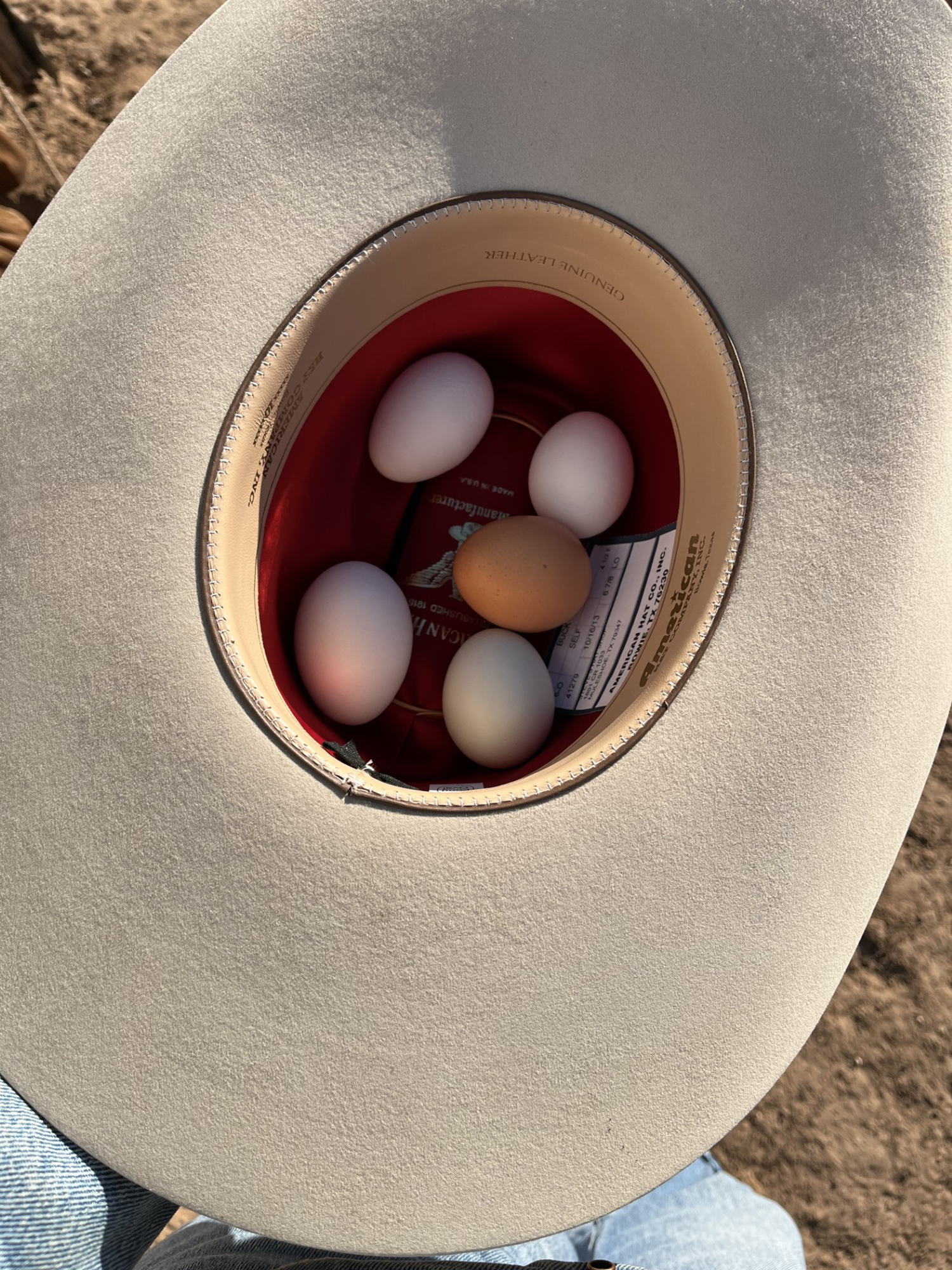
By Summer McMillen
All my married life I have thought that when husbands all got together horseback after a hard days work they were probably rating their wives on a scale from one to ten based on their various capabilities. Did Wife A have a good hat crease? Was Wife B good help in the branding pen? Was Wife C an excellent mother? Was Wife D hospitable to everyone? Could Wife E make a decent gallon of sweet tea? Did Wife F keep a tidy saddle house?
Presumably, when Wife B did not live up to Wife A there was a fist fight followed by wife shaming of Husband B. His status amongst the cowboys immediately fell and he would be behind for the rest of his life in his cowboy career.
He would come home ashamed his wife couldn’t flambé a decent bananas foster and she couldn’t hoolihan either. He would be distraught and said wife would feel his pain.
Of course, this never happened to me like I thought it would. My husband always came home with a smile on his face and I’m pretty sure “flambé” isn’t even in a cowboys vocabulary.
Nonetheless, these imaginary fights and social rankings have plagued my brain for years. It has caused me to always be in competition with myself to be the very best at everything I did. Which I have eventually realized is a trait of women all around the world.
While we are cooking a four course meal for our families we start to think about how we actually should be practicing heading steers instead.
While we are practicing our horsemanship we start to think about how we should actually be preparing a nutritious and elaborate meal for our families.
It is a constant battle that women have created and proceeded to fight for centuries.
One day the inner battle got to me and I finally broke down as we were riding wheat pasture and confessed to my husband my guilt. I was so sorry that I wasn’t a better cowgirl. I was so sorry that the house was a mess. I was so sorry that I would never be on The Cowboy Channel. I was so sorry that I had lost his good pair of gloves. (Except I didn’t actually mean to confess that last part. Some things are just better left unknown.) I apologized again and again and told him I was sorry and he probably never wanted to bring his friends over for supper ever again.
Instead of consoling me, he just started looking at me like I was crazy. Which is what all good husbands do.
He stopped his horse and looked at me and said “Do you know how cowboys rate each other’s ranch wives?”
So many thoughts started filling my brain. Was it looks? Gentleness? Laundry speed? Work ethic?
Then he revealed their secret. “Cowboys rate each other’s wives by how well they can cook eggs for breakfast.”
His point of course, was that men don’t think about each other’s wives. As long as they get their eggs for breakfast. In another twist of irony, my husband taught me how to fry the perfect egg. What can I say? It’s a man’s world.
Since then, I have let go of my irrational fears and doubt and have simply been living life. It’s all anyone can do. I may not team rope the best. I may get my fingers when I’m trying to dally and I may not have the tidiest saddle house. But I try hard at everything I do and I do it all out of love for my family and finally, myself.
So, if you’re a woman this Mother’s Day and you catch yourself feeling down amongst life constant pressures just remember you are not alone. You can almost guarantee there is a woman in every household that needs a little pick me up. Maybe you should just go outside. Maybe you should sit down and count your blessings. Or, maybe you should have your husband fry you some eggs.
-

 Attractions8 years ago
Attractions8 years ago48 Hours in Atoka Remembered
-

 Country Lifestyle9 months ago
Country Lifestyle9 months agoJuly 2017 Profile: J.W. Hart
-

 Country Lifestyle9 years ago
Country Lifestyle9 years agoThe House a Treasure Built
-

 Country Lifestyle3 years ago
Country Lifestyle3 years agoThe Two Sides of Colten Jesse
-

 Outdoors7 years ago
Outdoors7 years agoGrazing Oklahoma: Honey Locust
-

 Equine8 years ago
Equine8 years agoUmbilical Hernia
-

 Outdoors5 years ago
Outdoors5 years agoPecan Production Information: Online Resources for Growers
-

 Farm & Ranch7 years ago
Farm & Ranch7 years agoHackberry (Celtis spp.)

